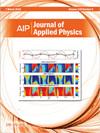Half-metallic magnetism in 2D MX2 (M = V, Cr, Mn, and Fe; X = S, Se, and Te) intercalated with 1D MX chains
IF 2.5
3区 物理与天体物理
Q2 PHYSICS, APPLIED
引用次数: 0
Abstract
Intercalation has attracted considerable attention due to its extensive ability to modify the electronic, optical, and magnetic properties of two-dimensional (2D) layered nanomaterials. Typically, dispersed atoms or molecules are inserted into the van der Waals gap of the 2D materials. Recently, Guo et al. experimentally reported the novel VS2–VS superlattice, where the intercalation takes the form of atomic chain arrays. In this study, we employed the first-principles calculations based on density functional theory to investigate a series of analogous 2D MX2–MX–MX2 nanomaterials, which, consisting of 2D transition metal dichalcogenide bilayers, intercalated with a one-dimensional transition metal chalcogenide MX chain array, forming a hotdog-like structure. Some of the 2D MX2–MX–MX2 are thermally and dynamically stable, suggesting their potential for experimental fabrication similar to VS2–VS–VS2. MnS2–MnS–MnS2 and MnSe2–MnSe–MnSe2 have been found to exhibit ferromagnetic half-metallic properties. In addition, VSe2–VSe–VSe2, CrS2–CrS–CrS2, and CrSe2–CrSe–CrSe2 have been found to be thermally and dynamically stable. Under appropriate external stress, doping, or bias, they could become ferromagnetic half-metals, revealing their potential for spintronic applications.二维MX2 (M = V, Cr, Mn, Fe)的半金属磁性X = S, Se,和Te)嵌入1D MX链
由于其广泛的改变二维(2D)层状纳米材料的电子、光学和磁性的能力,嵌入引起了相当大的关注。通常,分散的原子或分子被插入到二维材料的范德华隙中。最近,Guo等人通过实验报道了一种新的VS2-VS超晶格,其中的插层采用原子链阵列的形式。在本研究中,我们采用基于密度泛函理论的第一性原理计算研究了一系列类似的二维MX2-MX-MX2纳米材料,这些材料由二维过渡金属二硫族化物双层组成,嵌入一维过渡金属硫族化物MX链阵列,形成类似热狗的结构。一些二维MX2-MX-MX2具有热稳定性和动态稳定性,表明它们具有类似于VS2-VS-VS2的实验制造潜力。MnS2-MnS-MnS2和MnSe2-MnSe-MnSe2表现出铁磁性半金属性质。此外,还发现VSe2-VSe-VSe2、CrS2-CrS-CrS2和CrSe2-CrSe-CrSe2具有热稳定性和动力学稳定性。在适当的外部应力、掺杂或偏置下,它们可以成为铁磁性半金属,揭示了它们在自旋电子应用方面的潜力。
本文章由计算机程序翻译,如有差异,请以英文原文为准。
求助全文
约1分钟内获得全文
求助全文
来源期刊

Journal of Applied Physics
物理-物理:应用
CiteScore
5.40
自引率
9.40%
发文量
1534
审稿时长
2.3 months
期刊介绍:
The Journal of Applied Physics (JAP) is an influential international journal publishing significant new experimental and theoretical results of applied physics research.
Topics covered in JAP are diverse and reflect the most current applied physics research, including:
Dielectrics, ferroelectrics, and multiferroics-
Electrical discharges, plasmas, and plasma-surface interactions-
Emerging, interdisciplinary, and other fields of applied physics-
Magnetism, spintronics, and superconductivity-
Organic-Inorganic systems, including organic electronics-
Photonics, plasmonics, photovoltaics, lasers, optical materials, and phenomena-
Physics of devices and sensors-
Physics of materials, including electrical, thermal, mechanical and other properties-
Physics of matter under extreme conditions-
Physics of nanoscale and low-dimensional systems, including atomic and quantum phenomena-
Physics of semiconductors-
Soft matter, fluids, and biophysics-
Thin films, interfaces, and surfaces
 求助内容:
求助内容: 应助结果提醒方式:
应助结果提醒方式:


